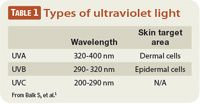Ultraviolet radiation exposure and melanoma
The incidence of childhood melanoma is increasing. There is evidence that cumulative exposure to ultraviolet radiation from the sun in the first 18 years of life contributes to the development of future skin cancers.

Ultraviolet B intensity is greatest during the summer, at midday, closer to the equator, and at higher altitudes.1 The absorption of photons by DNA in the epidermis causes dimerization of cyclobutane pyrimidine dimers. Incorrect repair of these dimers results in mutations in epidermal keratinocytes, which in turn causes cancer.
Unlike UVB radiation, UVA radiation is relatively constant throughout the year.1 Ultraviolet A radiation can penetrate deeper into the dermis and cause oxidative damage to the DNA in fibroblasts. Although solar radiation consists primarily of UVA rays, artificial sources of radiation may include significant components of UVA and UVB radiation.
Ultraviolet radiation and skin cancer

Although basal cell carcinoma and malignant melanoma have been more closely linked to the intermittent bursts of sun exposure experienced during sun burning and tanning, squamous cell carcinoma has been more tightly associated with chronic and cumulative UVB exposure.1 Studies suggest that persons who use tanning beds are 2.5 times more likely to develop squamous cell carcinoma and 1.5 times more likely to develop basal cell carcinoma.2
Melanoma studies have shown that artificial UV light exposure increases the risk of developing melanoma by 74%.3 In 2011 alone, it is estimated that there were 70,230 new cases of melanoma diagnosed in persons of all ages.4
Dupilumab safe, effective for up to 1 year for atopic dermatitis in infants, preschool children
May 3rd 2024According to new study data presented at the 2024 Pediatric Academic Societies Meeting, dupilumab (dupixent; Sanofi and Regeneron) demonstrated positive safety and efficacy results for up to 1 year in infants and preschool-age children with atopic dermatitis.
Recognize & Refer: Hemangiomas in pediatrics
July 17th 2019Contemporary Pediatrics sits down exclusively with Sheila Fallon Friedlander, MD, a professor dermatology and pediatrics, to discuss the one key condition for which she believes community pediatricians should be especially aware-hemangiomas.
Young woman with tick bites presents with erythematous papules, headaches, and fatigue
April 8th 2024A young woman with no significant past medical history returns from hiking with several white-spotted ticks and experiences erythematous papules, rashes, headaches, and fatigue. What’s the diagnosis?